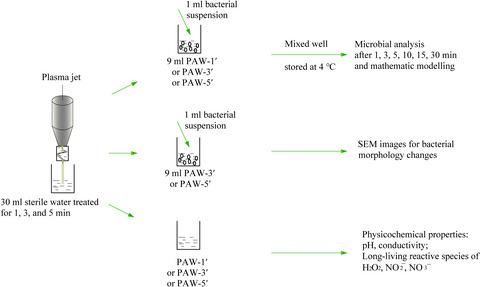当前位置:
X-MOL 学术
›
Int. J. Food Sci. Tech.
›
论文详情
Our official English website, www.x-mol.net, welcomes your
feedback! (Note: you will need to create a separate account there.)
Inactivation efficacy of plasma‐activated water: influence of plasma treatment time, exposure time and bacterial species
International Journal of Food Science & Technology ( IF 2.6 ) Pub Date : 2020-07-06 , DOI: 10.1111/ijfs.14708 Yi‐Ming Zhao 1, 2 , Shikha Ojha 2, 3 , Catherine M. Burgess 2 , Da‐Wen Sun 1 , Brijesh K. Tiwari 2
International Journal of Food Science & Technology ( IF 2.6 ) Pub Date : 2020-07-06 , DOI: 10.1111/ijfs.14708 Yi‐Ming Zhao 1, 2 , Shikha Ojha 2, 3 , Catherine M. Burgess 2 , Da‐Wen Sun 1 , Brijesh K. Tiwari 2
Affiliation

|
This study aimed to evaluate the influence of plasma treatment time, bacterial exposure time to PAW and bacterial species on the inactivation efficacy of plasma‐activated water (PAW), with additional investigation of the inactivation mechanisms of PAW. Six bacterial species, including Listeria innocua, Staphyloccus aureus, Escherichia coli, Pseudomonas fluorescens, Shewanella putrefaciens and Aeromonas hydrophila were selected as the representative bacteria. The initial bacterial concentration was around 7 log CFU ml−1 after mixing with PAW, and the inactivation efficacy was measured after different exposure times during the 4 °C storage. Scanning electron microscopy (SEM) images of the bacteria after PAW treatment were carried out to inspect the cell structure damage, and physicochemical properties of PAW, including pH, conductivity and long‐living reactive species of H2O2,  , and
, and  , were examined. The results showed that the inactivation efficacy of PAW was positively correlated with plasma treatment time and bacterial exposure time, and for the species examined in this study, the Gram‐negative species were more sensitive to PAW than the Gram‐positive species. Cell structure damage, including shrinkage, distortion, or holes, was observed after PAW treatment. The pH of PAW was acidified to 2.5–2.9, and conductivity was significantly increased to 518.0 μs cm−1.
, were examined. The results showed that the inactivation efficacy of PAW was positively correlated with plasma treatment time and bacterial exposure time, and for the species examined in this study, the Gram‐negative species were more sensitive to PAW than the Gram‐positive species. Cell structure damage, including shrinkage, distortion, or holes, was observed after PAW treatment. The pH of PAW was acidified to 2.5–2.9, and conductivity was significantly increased to 518.0 μs cm−1.  and H2O2 were reduced during the 48 h storage, while an increased concentration was observed for
and H2O2 were reduced during the 48 h storage, while an increased concentration was observed for  . This study demonstrated that the processing parameters of plasma treatment time, exposure time and characteristics of bacteria can significantly affect the inactivation efficacy of PAW.
. This study demonstrated that the processing parameters of plasma treatment time, exposure time and characteristics of bacteria can significantly affect the inactivation efficacy of PAW.
中文翻译:

血浆活化水的灭活功效:血浆处理时间,暴露时间和细菌种类的影响
本研究旨在评估血浆处理时间,细菌暴露于PAW的时间和细菌种类对血浆活化水(PAW)灭活效果的影响,并进一步研究PAW的灭活机理。选择6种细菌为代表性细菌,包括无毒李斯特菌,金黄色葡萄球菌,大肠杆菌,荧光假单胞菌,腐烂希瓦氏菌和嗜水气单胞菌。初始细菌浓度约为7 log CFU ml -1与PAW混合后,在4°C的储存条件下经过不同的暴露时间后,测定了灭活功效。扫描电子显微镜(SEM)后PAW治疗进行了检查的细胞结构破坏的细菌,和PAW的物理化学特性,包括pH,导电率及H长寿命的反应性物种的图像2 ö 2, 和
和 ,进行了检查。结果表明,PAW的灭活效果与血浆处理时间和细菌暴露时间呈正相关,对于本研究中检测到的物种,革兰氏阴性菌对PAW的敏感性高于革兰氏阳性菌。在PAW处理后,观察到细胞结构受损,包括收缩,变形或孔洞。PAW的pH酸化至2.5-2.9,电导率显着增加至518.0μscm -1。
,进行了检查。结果表明,PAW的灭活效果与血浆处理时间和细菌暴露时间呈正相关,对于本研究中检测到的物种,革兰氏阴性菌对PAW的敏感性高于革兰氏阳性菌。在PAW处理后,观察到细胞结构受损,包括收缩,变形或孔洞。PAW的pH酸化至2.5-2.9,电导率显着增加至518.0μscm -1。 和H 2 O 2在48小时的储存过程中减少,而
和H 2 O 2在48小时的储存过程中减少,而 。这项研究表明,血浆处理时间,暴露时间和细菌特性的加工参数可以显着影响PAW的灭活效果。
。这项研究表明,血浆处理时间,暴露时间和细菌特性的加工参数可以显着影响PAW的灭活效果。
更新日期:2020-07-06
 , and
, and  , were examined. The results showed that the inactivation efficacy of PAW was positively correlated with plasma treatment time and bacterial exposure time, and for the species examined in this study, the Gram‐negative species were more sensitive to PAW than the Gram‐positive species. Cell structure damage, including shrinkage, distortion, or holes, was observed after PAW treatment. The pH of PAW was acidified to 2.5–2.9, and conductivity was significantly increased to 518.0 μs cm−1.
, were examined. The results showed that the inactivation efficacy of PAW was positively correlated with plasma treatment time and bacterial exposure time, and for the species examined in this study, the Gram‐negative species were more sensitive to PAW than the Gram‐positive species. Cell structure damage, including shrinkage, distortion, or holes, was observed after PAW treatment. The pH of PAW was acidified to 2.5–2.9, and conductivity was significantly increased to 518.0 μs cm−1.  and H2O2 were reduced during the 48 h storage, while an increased concentration was observed for
and H2O2 were reduced during the 48 h storage, while an increased concentration was observed for  . This study demonstrated that the processing parameters of plasma treatment time, exposure time and characteristics of bacteria can significantly affect the inactivation efficacy of PAW.
. This study demonstrated that the processing parameters of plasma treatment time, exposure time and characteristics of bacteria can significantly affect the inactivation efficacy of PAW.
中文翻译:

血浆活化水的灭活功效:血浆处理时间,暴露时间和细菌种类的影响
本研究旨在评估血浆处理时间,细菌暴露于PAW的时间和细菌种类对血浆活化水(PAW)灭活效果的影响,并进一步研究PAW的灭活机理。选择6种细菌为代表性细菌,包括无毒李斯特菌,金黄色葡萄球菌,大肠杆菌,荧光假单胞菌,腐烂希瓦氏菌和嗜水气单胞菌。初始细菌浓度约为7 log CFU ml -1与PAW混合后,在4°C的储存条件下经过不同的暴露时间后,测定了灭活功效。扫描电子显微镜(SEM)后PAW治疗进行了检查的细胞结构破坏的细菌,和PAW的物理化学特性,包括pH,导电率及H长寿命的反应性物种的图像2 ö 2,
 和
和 ,进行了检查。结果表明,PAW的灭活效果与血浆处理时间和细菌暴露时间呈正相关,对于本研究中检测到的物种,革兰氏阴性菌对PAW的敏感性高于革兰氏阳性菌。在PAW处理后,观察到细胞结构受损,包括收缩,变形或孔洞。PAW的pH酸化至2.5-2.9,电导率显着增加至518.0μscm -1。
,进行了检查。结果表明,PAW的灭活效果与血浆处理时间和细菌暴露时间呈正相关,对于本研究中检测到的物种,革兰氏阴性菌对PAW的敏感性高于革兰氏阳性菌。在PAW处理后,观察到细胞结构受损,包括收缩,变形或孔洞。PAW的pH酸化至2.5-2.9,电导率显着增加至518.0μscm -1。 和H 2 O 2在48小时的储存过程中减少,而
和H 2 O 2在48小时的储存过程中减少,而 。这项研究表明,血浆处理时间,暴露时间和细菌特性的加工参数可以显着影响PAW的灭活效果。
。这项研究表明,血浆处理时间,暴露时间和细菌特性的加工参数可以显着影响PAW的灭活效果。









































 京公网安备 11010802027423号
京公网安备 11010802027423号